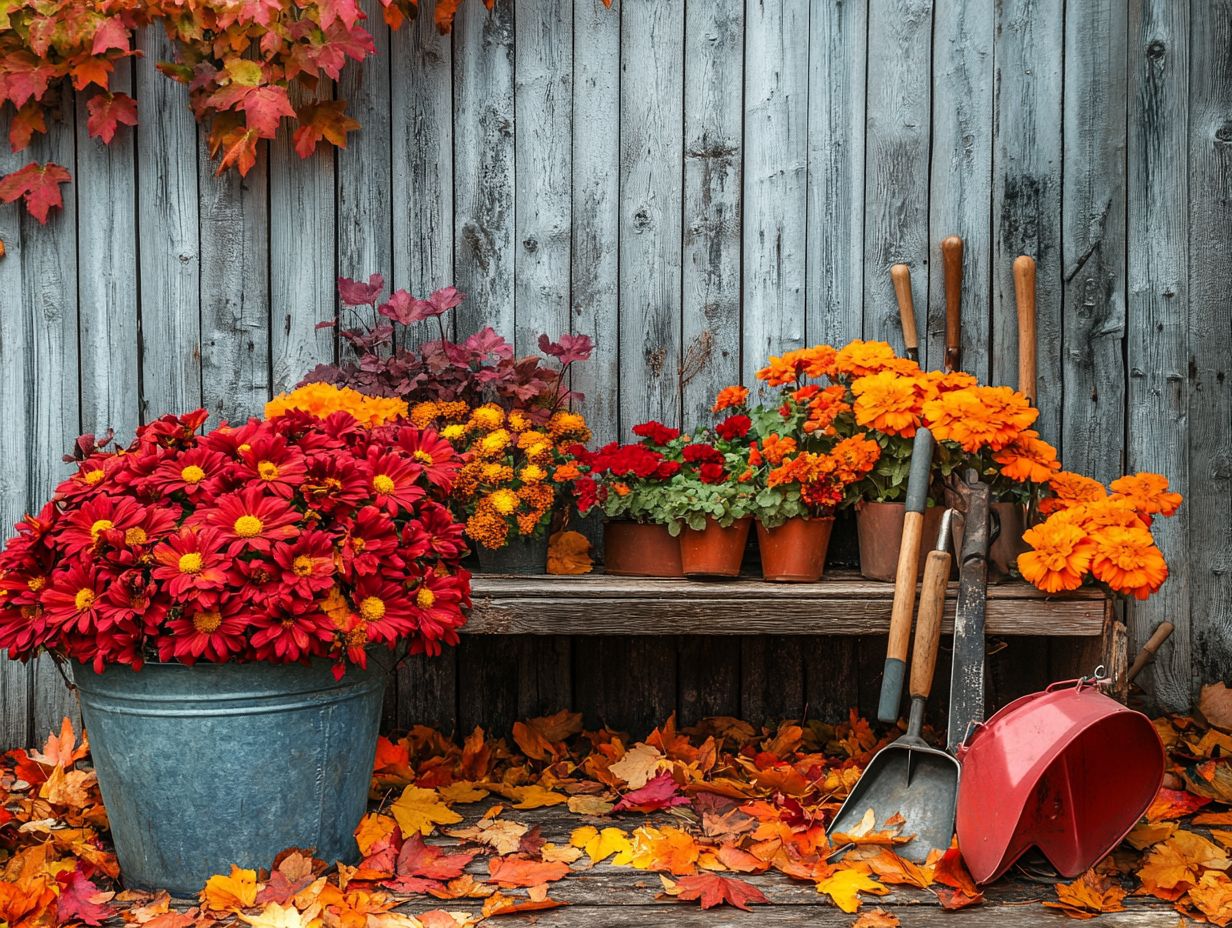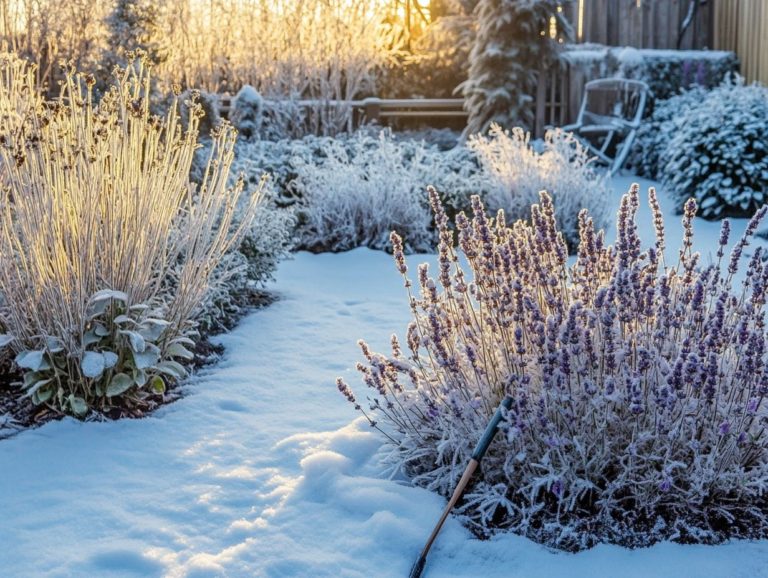Preparing Your Garden for Fall: Tips and Tricks
As summer gracefully retreats and autumn begins to make its presence known, get ready to prepare your garden for the changing seasons.
Fall presents a unique opportunity to tidy up, introduce new plant varieties, and shield your garden from the impending chill. Let s explore how cleaning your garden can prepare it for a beautiful fall!
You will find valuable tips to prepare you for a vibrant spring. Get ready to embrace the enchanting beauty of fall gardening!
Contents
- Key Takeaways:
- Why Prepare Your Garden for Fall?
- Cleaning Up Your Garden
- Planting for Fall
- Choosing the Right Fall Plants
- Protecting Your Garden
- Methods for Protecting Plants from Cold Weather
- Preparing for Next Spring
- Steps to Ensure a Successful Spring Garden
- Frequently Asked Questions
- Wondering how to get your garden ready for fall?
- When should I start preparing my garden for fall?
- Do I need to fertilize my garden before fall?
- What types of plants should I add to my fall garden?
- How can I protect my garden from frost in the fall?
- What should I do with my garden tools after preparing for fall?
Key Takeaways:

- Fall garden preparation is crucial for maintaining a healthy and thriving garden throughout the changing seasons.
- Clean up your garden by removing summer plants and debris to make room for new fall plantings and to prevent diseases and pests from overwintering.
- Protect your plants from cold weather by using methods such as mulching, covering, and using cold frames or greenhouses.
Why Prepare Your Garden for Fall?
Preparing your garden for fall is essential for a successful transition from the vibrant summer months to the cooler embrace of autumn. This seasonal shift maximizes your vegetable garden’s yield before winter arrives and enriches your soil with organic matter. For detailed guidance, check out preparing your garden for winter.
Gardening experts emphasize that careful preparation for fall can profoundly impact your garden’s health, vitality, and productivity, especially when preparing your planting beds for winter, setting the stage for a bountiful spring ahead.
The Importance of Preparing for the Changing Seasons
Understanding the significance of preparing your garden for the changing seasons can enhance your gardening experience and results.
As the weather shifts, your soil undergoes transformations that directly affect its fertility. Each season brings challenges and opportunities, making it crucial to adapt your strategies accordingly.
Fall heralds a transitional period where specific seasonal plants, such as hardy varieties like kale and broccoli, truly shine. By recognizing these patterns and preparing your soil effectively, you can ensure that your garden is primed for robust growth.
Transitioning to cool-weather crops not only aids in cultivating nutrient-rich vegetables but also plays a vital role in maintaining soil health throughout the colder months.
Cleaning Up Your Garden
Cleaning up your garden is a vital endeavor that readies your outdoor sanctuary for the forthcoming seasons. This meticulous process enhances the beauty of your space and promotes the longevity and vitality of your plants.
Removing Summer Plants and Debris

Removing summer plants and debris is essential for preventing pest infestations. This process paves the way for new growth and plays a crucial role in mitigating potential plant diseases.
Begin by uprooting any remaining summer crops. Take care to dispose of diseased plants properly to prevent the spread of pathogens. Once the area is clear, consider incorporating kitchen scraps like vegetable peels and coffee grounds into a compost bin. This practice enriches the soil and fosters a healthy garden ecosystem.
By doing this, you provide beneficial nutrients that promote robust plant growth when spring arrives.
Planting for Fall
When planting for fall, choose the right vegetables and cool-season crops. This thoughtful selection guarantees a vibrant and productive garden throughout the autumn months.
Start preparing your garden now to enjoy the benefits of fall planting!
Choosing the Right Fall Plants
Choosing the right fall plants, including vibrant flowers and seasonal greenery, is essential for crafting a thriving and visually stunning garden. These plants infuse your space with rich colors and endure cooler temperatures, making them an ideal choice for autumn landscapes.
To achieve a bountiful display, select varieties that flourish in the waning sunlight and unpredictable temperatures of fall. Equip yourself with the right gardening tools like trowels and pruners, which help manage your garden effortlessly. Adding organic fertilizers enriches the soil, providing essential nutrients for vigorous growth.
When selecting plants, consider strong plants that come back each year and ornamental grasses. These resilient species thrive during this transitional season, ensuring your garden remains beautiful into the cooler months.
Protecting Your Garden
Safeguarding your garden from the relentless chill of cold weather is crucial for nurturing your plants’ wellbeing throughout fall and winter.
Methods for Protecting Plants from Cold Weather

Using effective methods to protect your plants from cold weather ensures your garden thrives and stays healthy all winter. Consider adding green manure, which includes cover crops that improve soil health.
One effective strategy is mulching your garden beds. Mulching helps keep the soil warm and moist, which is great for your plants! A thick layer of mulch creates a protective barrier, safeguarding root systems from frigid temperatures and fostering resilience during harsh conditions.
Incorporating cover crops or green manure significantly enhances soil health, improving its structure and nutrient content while shielding it from erosion. Together, these practices cultivate a vibrant garden ecosystem, showing how proactive measures can lead to rewarding results, even in colder months.
Preparing for Next Spring
Preparing for spring begins in the fall when meticulous garden maintenance and thoughtful planning set the stage for a flourishing spring garden. This includes trimming back overgrown perennials and ensuring the soil structure supports root growth.
By nurturing your garden now, you’re ensuring a bountiful and beautiful display when the season arrives.
Steps to Ensure a Successful Spring Garden
To cultivate a thriving spring garden, follow specific steps that include proper soil amendments and understanding the seasonal transition. This preparation lays the groundwork for vibrant blooms and bountiful vegetables, enhancing the overall growth and vitality of each plant.
- Assess your soil composition; the right structure is essential for robust root development.
- Conduct a soil test early to pinpoint any nutrient deficiencies.
- Once you know your soil’s needs, enrich it with organic matter like compost or aged manure to improve soil fertility.
- Tilling the soil can improve aeration, allowing roots to penetrate more deeply.
Keep a close eye on weather patterns, as they greatly influence your planting timing and strategies. With these considerations, you ll be well on your way to a flourishing garden.
Frequently Asked Questions
Wondering how to get your garden ready for fall?

To prepare your garden for fall, start by removing any dead or dying plants and debris. This creates space for new growth and prevents diseases from spreading. Next, trim back any overgrown plants and trees, and clean and sharpen your gardening tools. Finally, follow these essential steps for preparing your garden for winter by adding a layer of mulch to protect your plants from cooler temperatures.
When should I start preparing my garden for fall?
Start preparing your garden for fall at the end of summer or the beginning of fall. This timing helps your plants adapt to changing weather.
Do I need to fertilize my garden before fall?
Yes, fertilizing is crucial before fall. It strengthens roots and helps plants absorb nutrients for the colder months.
Choose a slow-release fertilizer, which releases nutrients gradually, and follow the package instructions.
What types of plants should I add to my fall garden?
Fall is perfect for adding cool-weather plants. Popular choices include mums, pansies, and ornamental kale, which thrive in cooler temperatures and add vibrant colors.
How can I protect my garden from frost in the fall?
Cover delicate plants with a lightweight fabric or sheet to shield them from frost. This barrier traps heat and protects against freezing temperatures.
Water your plants before a freeze. Moist soil can help insulate them from the cold.
What should I do with my garden tools after preparing for fall?
After preparation, clean and store your tools properly. Wipe them down, sharpen the blades, and keep them in a dry place.
This care extends their lifespan and ensures they re ready for spring.






